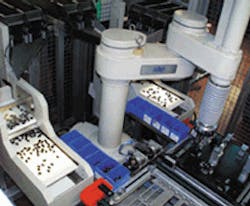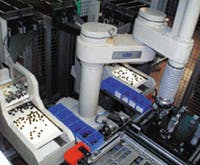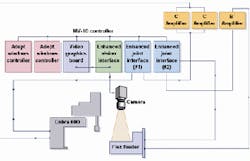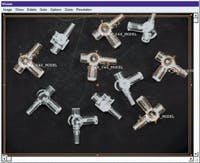Flexible Vision-Based Robotic System Assembles Varied Parts
Automotive switches and sensors can be accurately assembled on the production line by a vision-equipped robot without costly and lengthy retooling changes.
By Lawrence J. Curran,Contributing Editor
Most robotic assembly lines require retooling and custom fixtures to accommodate changes for different component assemblies. These expensive and time-consuming requirements have been minimized by The Valeo Group (Paris, France), which uses vision-equipped robots
to manufacture components and subsystems for the automotive industry. The company uses tabletop robots, flexible part feeders, and associated vision components from Adept Technology Inc. (San Jose, CA) to assemble a variety of automotive switches and sensors in its Valeo Electronics Werk (Wemding, Germany) facility. This facility is part of Valeo's Switch and Sensors Europe division.
According to Leonhard Mugratsch, Valeo senior project manager, flexibility is a primary benefit derived from using an integrated robotic system. The system enables the company to build a variety of switches or sensors on one assembly line without cumbersome tooling changes that slow down production operations. Vision-based robots also allow faster and more accurate assembly with fewer miss-mated parts than can occur with conventional robotic assemblies, he adds.
"We can assemble steering-column switches in the morning and rocker switches in the afternoon by making a simple software change in the vision subsystem," Mugratsch says. According to Joe Campbell, Adept's vice president of marketing, this kind of flexibility "was one of the promises held out for vision in robots from the start, and we think we're delivering on that promise."
Shared history
The two companies have been affiliated for more than a decade, having connected initially when Valeo Electronics was part of the ITT Automotive Group in Germany. That organization used earlier Adept robots. Valeo's Mugratsch points out that after the acquisition of Valeo Electronics by The Valeo Group, a company survey indicated that Adept's robots provided the precision required for its component assemblies.
FIGURE 1. Valeo Group's vision-equipped robotic system uses the Adept Technology vision, robot, and FlexFeeder subsystems to assemble a variety of automotive switch modules. The tray feeder and chute assemblies (top left) drop microswitch modules onto the FlexFeeder belts (left). The numbered modules are image-captured by a Panasonic camera. They are then picked up by the robot's gripper for insertion into housings carried by a pallet located beneath the gripper (bottom right).
The products of the Valeo Electronics Switch and Sensor Europe division include steering-column, steering-angle, and headlight switches and rain sensors, among others. "These are small mechanical and electromechanical components," says Adept's Campbell, "and that's one of our key application areas."
FIGURE 2. In the Adept Technology vision-based Cobra 600 robot, a controller chassis houses the six circuit boards needed to direct system operations. The video graphics board delivers the vision system's output images to a monitor screen for viewing. Two Adept Windows Controller boards use Motorola MC68060 microprocessors to run the operating system and control the robot's trajectory planning. Two enhanced-joint-interface boards are dedicated to the robot's four-axis motions and servo-loop low-level motor control. In addition to vision interfacing, the enhanced-vision-interface board also controls the FlexFeeder movements.
The Valeo Electronics division facility has a dozen Adept systems running, each of which includes a Cobra 600 four-axis robot, two FlexFeeder 250 units, a MV-10 controller, and VXL vision-guided robotics software (see Fig. 1). The list price for this typical setup is approximately $67,000, Campbell says. Valeo's Mugratsch expects the division facility to be equipped with 15 robot-based systems in the next six months "and twice that many in the next two or three years."
The Cobra 600 robot provides a reach of 600 mm (23.6 in.) and a z-axis stroke of 210 mm (8.3 in.) and can accommodate a load of 5.5 kg (12.1 lb). Adept's Campbell says this robot is the company's highest-volume seller. It uses the same base-mounting pattern as the earlier Adept 550 series robots. This compatibility was important to Valeo because it is still using these earlier models. The Cobra 600 robot also uses the same tool flange as the 550 series, enabling easy tool interchangeability.
The FlexFeeder implements three servo-driven bidirectional conveyor belts, an integrated bulk-storage hopper, and a high-frequency fluorescent light source. The unit essentially operates as an intelligent conveyance system for feeding small parts in random orientation, size, shape, and bulk. It includes a vision system and an intelligent controller that can recirculate parts that are not selected during the first pass.
Designed and manufactured by Adept, the Cobra 600 robot, FlexFeeder, and MV-10 controller have been integrated by Valeo with specialized grippers, an enhanced vision-interface (EVI) board, and two Panasonic Medical & Industrial Video Co. (Secaucus, NJ) MF-602 RS-170, 640 x 480-pixel cameras (see Fig. 2 on p. 26). A video graphics board (VGB) delivers the vision system's output to a monitor screen in the Valeo installation, which does not use a personal computer.
The VGB resides in the controller, along with five other circuit boards. Two boards serve as Adept Windows Controllers, which use MC68060 microprocessors from Motorola Semiconductor Products (Austin, TX) to run the operating system and control the robot's trajectory planning. Two enhanced-joint-interface (EJI) boards are dedicated to the robot's four-axis motions and servo-loop low-level motor control. In addition to vision interfacing, the EVI board also controls FlexFeeder conveyor-belt movements.
FIGURE 3. The vision-equipped robotic-system monitor shows several different orientations of the microswitch modules on a conveyor belt. The modules contain model numbers, carried as tags, to assist in selecting the correct ones for assembly into the matching housing on the pallet holding the switch housings.
The EVI boards can support as many as four cameras; however, Valeo uses only two in this installation. They provide dual 1024 x 1024 frame stores and four user-configurable frame buffers and include an on-board convolver chip that can perform convolutions of up to a 7 x 7-size kernel.
The system also is equipped with the AdeptVision VXL software, which features the company's ObjectFinder vision tool set. This geometry-based object-recognition software can locate a part accurately over a 360° rotation, as well as locate touching or partially occluded parts (see Fig. 3).
Adept's Campbell says the purpose of the FlexFeeder subsystem is to allow the robot to select parts without the need for dedicated tooling and fixturing for each different component to be assembled. Valeo's Mugratsch says that flexibility is the basis for Valeo's adoption of the system.
Bring it all together
In operation, the robot at a given station is always running. A conveyor belt moves two pallets—one beside the other—into the two FlexFeeder stations, where the pallets are stopped. The two cameras initially identify which microswitch-module housings are carried on the pallets. That information is then used by the robot controller to select the proper program and location options to pick up the correct components for assembly into the housing.
Microswitch modules to be inserted into the pallet-borne housings are delivered to the FlexFeeder by a conveyor-and-tray feeder system provided to Valeo by Robert Bosch GmbH (Stuttgart, Germany). Mugratsch says that five trays serve each FlexFeeder, delivering microswitch-module components through a chute that drops them onto the top-most or feed belt of the unit's three continuously moving conveyor belts. The components are then dropped to the next lower or pick-up belt, which moves in the same direction as the feed belt but at a higher speed to provide more separation among parts.
Rapid oscillating or "jiggling" of the pick-up belt, whose amplitude and frequency are programmable, adjusts the parts that are incorrectly positioned. The jiggling motion also redistributes the parts before images are taken by the vision system. Two flipping stations, which are located at the bottom center of the system between two rows of bins, assist in overturning those modules that are still not properly oriented for pickup by the robot's grippers.
One Panasonic camera is mounted above each FlexFeeder. The generated images determine whether the modules, which carry visible numbers, on the pick-up belt are indeed the correct components for a given microswitch assembly and that they are properly oriented. Fluorescent backlighting, which provides sufficient illumination for the camera, is mounted below the pick-up belt.
Multiple modules
The two pallets that hold the housings into which the robot's grippers place the microswitch modules are arranged side-by-side at the right of the flipping stations. Mugratsch says from four to nine modules might be inserted into a given housing to complete a switch assembly.
A Bosch-supplied data carrier, working in conjunction with the vision system, determines how many and which modules can be inserted into the switch being assembled. The camera and data carrier also verify that the switch is correctly assembled before activating the conveyor holding the pallet with finished switches to move out of the robot cell when the housing assembly is completed.
One Cobra 600 robot serves two FlexFeeder stations. The conveyors move continuously while the vision system acquires images. The robot is synchronized with the conveyor belt, and image capture allows the accurate pickup of parts from the moving conveyor belt.
The bottom FlexFeeder conveyor—the lowest or return belt—moves in the opposite direction from the upper two belts and returns improperly oriented components that were rejected by the vision system to a bucket feeder. In turn, the bucket feeder raises the rejected parts to the top-most belt to begin the assembly cycle again.
Mugratsch points out that all activities of the robot cell are directed by the Adept controller, and no other software is required. The controller activities include feeding the microswitch modules through the chutes to the FlexFeeders and then on through to the robot's motions and grippers and end with pallet movement out of the robot cell.
According to Mugratsch use of the system has allowed Valeo Electronics to "easily combine the vision, robot, and FlexFeeders into a complete system, which requires only a single controller, to fit a robot cell."
Company Information
Adept Technology Inc.
San Jose, CA 95134
(408) 432-0888
Fax: (408) 432-8707
Web: www.adept.com
Motorola Semiconductor Products
Austin, TX 78735
(512) 895-6217
Web: www.mot-sps.com
Panasonic Medical & Industrial Video Co.
Secaucus, NJ 07094
(201) 392-6674
Web: www.panasonic.com
Robert Bosch GmbH
D-70049 Stuttgart, Germany
(49) 711 811-0
Web: www.bosch.com
Valeo Electronics Werk
4-86650 Wemding, Germany
(49) 9092-6030
Fax: (49) 9090-603-113
Web: www-db.valeo.com



